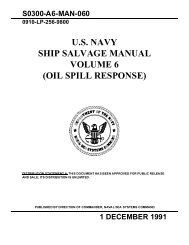April 2007 - Supervisor of Salvage and Diving
April 2007 - Supervisor of Salvage and Diving
April 2007 - Supervisor of Salvage and Diving
You also want an ePaper? Increase the reach of your titles
YUMPU automatically turns print PDFs into web optimized ePapers that Google loves.
USNS APACHE (T-ATF 172)<br />
responded to a shipboard fire aboard<br />
a commercial freighter while repairing the<br />
commercial pier in port <strong>of</strong> Monrovia,<br />
Liberia <strong>and</strong> surveying the city’s harbor on<br />
August 10, 2006.<br />
The engine room <strong>of</strong> Tahoma Reefer,<br />
an Estonian commercial freighter also<br />
paying a call on Monrovia’s port, burst<br />
into flames in the early hours <strong>of</strong> the day.<br />
Later that morning, just as smoke from<br />
the burning vessel was spotted from<br />
APACHE’s bridge, the U.S. Embassy in<br />
Liberia phoned the ship <strong>and</strong> asked the<br />
crew to respond.<br />
Using the ship’s rigid hull inflatable<br />
(RHIB) boat, APACHE Chief Mate Troy<br />
Bruemmer <strong>and</strong> Chief Warrant Officer<br />
Pete Sharpe, Officer-in-Charge <strong>of</strong> the<br />
12 member embarked Mobile <strong>Diving</strong><br />
<strong>and</strong> <strong>Salvage</strong> Unit 2, <strong>and</strong> three other<br />
crewmembers, rushed to the scene.<br />
“When we arrived, we witnessed the deck<br />
house <strong>of</strong> the ship engulfed in flames,” said<br />
Sharpe. “All the crew <strong>and</strong> the harbor pilot<br />
were on the bow, some without life<br />
jackets. We returned to our ship to get<br />
more life jackets <strong>and</strong> additional Divers to<br />
assist.”<br />
While the crew aboard APACHE’s<br />
RHIB rescued the nine men aboard the<br />
freighter, the tug’s civilian master, CAPT<br />
Charles Rodriguez, put his ship into<br />
action. “As the Chief Mate, Warrant<br />
Officer, <strong>and</strong> Divers removed TAHOMA’s<br />
crew from the starboard side, APACHE<br />
approached the ship’s port side <strong>and</strong><br />
commenced fighting the fire,” said<br />
Rodriguez.<br />
Using the tug’s starboard fire stations,<br />
APACHE worked to put out the flames.<br />
More than four hours later, TAHOMA’s<br />
fire was under control.“Actions under<br />
unusual <strong>and</strong> hazardous situations is<br />
what makes life at sea so rewarding <strong>and</strong><br />
different every day,” said CAPT Nick<br />
Holman, Comm<strong>and</strong>er, Sealift Logistics<br />
Comm<strong>and</strong> Europe. “The cool heads<br />
<strong>and</strong> fast h<strong>and</strong>s <strong>of</strong> APACHE’s crew<br />
<strong>and</strong> embarked Navy Divers during<br />
this emergency situation represent<br />
seamanship at its best.”<br />
No crewmembers were injured<br />
during the operation. APACHE is a<br />
non-combatant ship operated by 16<br />
U.S. merchant mariners employed by the<br />
U.S. Navy’s Military Sealift Comm<strong>and</strong>.<br />
Submitted by Sealift Logistics Comm<strong>and</strong><br />
Europe.<br />
AT SEA ABOARD M/V KELLIE<br />
CHOUEST — A Navy Diver, submerged<br />
at 2,000 feet, set the record using<br />
the new Atmospheric <strong>Diving</strong> System<br />
(ADS) suit <strong>of</strong>f the coast <strong>of</strong> La Jolla,<br />
CA, August 1, 2006.<br />
Chief Navy Diver (DSW/SS) Daniel<br />
P. Jackson <strong>of</strong> Navy Reserve Deep<br />
Submergence Unit (DSU) was r<strong>and</strong>omly<br />
selected to certify the ADS suit for use by<br />
the Navy.<br />
“I feel like the luckiest guy in the<br />
world,” said Jackson. “I am honored <strong>and</strong><br />
privileged to be the first Diver to go down<br />
that depth.”<br />
The certification was the culmination<br />
<strong>of</strong> 11 years <strong>of</strong> planning, designing, <strong>and</strong><br />
testing by multiple agencies to develop the<br />
ADS suit, also known as the Hardsuit<br />
2000.<br />
“This is the biggest piece <strong>of</strong> teamwork<br />
that I have ever seen in the Navy,” said<br />
CDR Keith W. Lehnhardt, the Officer-in-<br />
Charge <strong>of</strong> the project.<br />
Lehnhardt said that the project was a<br />
collaboration <strong>of</strong> so many different<br />
organizations such as DSU, Submarine<br />
Squadron 5 <strong>and</strong> <strong>Diving</strong> Systems Support<br />
Detachment.<br />
Jackson said, “I was just a guy tied<br />
to a rope. It was the ADS team that made<br />
it all possible. They were incredible.”<br />
Developed by OceanWorks International<br />
from Vancouver, British Columbia,<br />
the Hardsuit 2000 was designed to withst<strong>and</strong><br />
underwater pressure at 2,000 feet.<br />
Current models have only been able to go<br />
down as far as 1,200 feet.<br />
“The suit worked incredible,” said<br />
Jackson. “It did everything it was intended<br />
to do. I always heard that around 1,300<br />
feet, the joints <strong>of</strong> the Hardsuit 2000 would<br />
work even better, <strong>and</strong> it worked exactly<br />
the way they said it would.”<br />
Meeting the Navy’s high safety requirements,<br />
the ADS suit was designed<br />
<strong>and</strong> acquired by the Navy to support submarine<br />
rescue. “Its specific purpose is to<br />
be part <strong>of</strong> the advance assessment system<br />
during a submarine rescue operation,” said<br />
Lehnhardt. “The Diver in the suit will see<br />
what the damage to the sub is <strong>and</strong> find out<br />
where the survivor might be.”<br />
Jackson said, “At 2,000 feet, I had<br />
topside turn <strong>of</strong>f all the lights, <strong>and</strong> it was<br />
like a star show. The phosphorescence that<br />
was naturally in the water <strong>and</strong> in most <strong>of</strong><br />
the sea life down there started to glow.<br />
When I started to travel back up, all the<br />
lights looked like a shower <strong>of</strong> stars going<br />
down as I was coming up. It was the best<br />
ride in the world.”<br />
Mass Communication Specialist 3rd Class<br />
Mark G. Logico, Fleet Public Affairs Center,<br />
Pacific.<br />
8 A p r i l 2 0 0 7

















